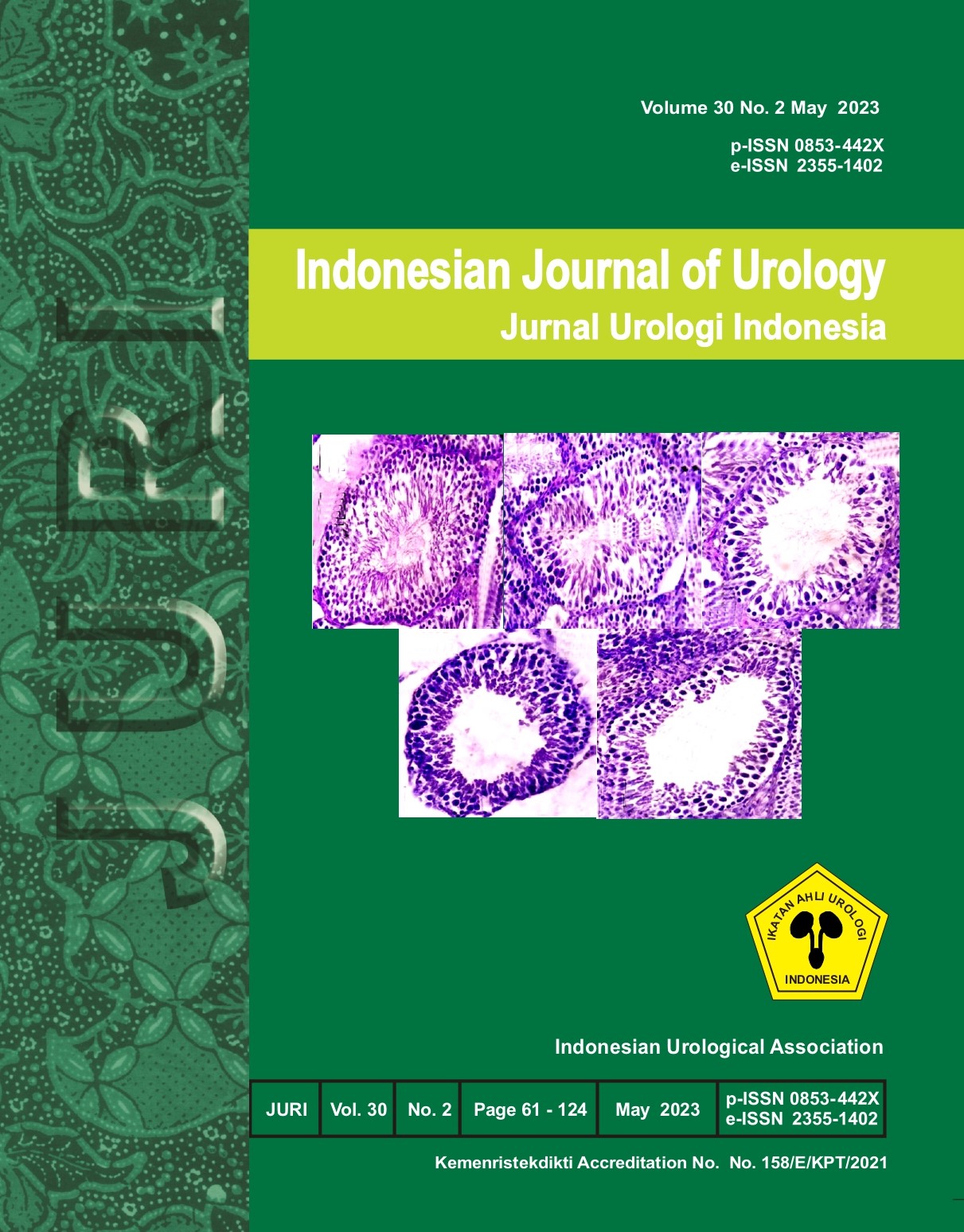EARLY-STAGE TESTICULAR CANCER MANAGEMENT REFERRING TO EUROPEAN ASSOCIATION OF UROLOGY (EAU) GUIDELINES: A SURVEY IN INDONESIA
##plugins.themes.bootstrap3.article.main##
##plugins.themes.bootstrap3.article.sidebar##
Abstract
Objective: This study aimed to determine the management of early-stage testicular cancer among urologists in Indonesia by using a survey. Material & Methods: This research was a descriptive-analytic study using a survey method through a Google-forms questionnaire distributed to urologists throughout Indonesia who were willing to participate. Data were collected from September 1 to 30, 2021. Results: Of the total respondents, 15 (14.2%) respondents were consultant urologic oncologists, and 90 (85.71%) respondents were non-consultant urologists or consultant urologists non-oncology. There was no difference in the treatment given by consultant uro-oncologists and non-consultant urologists/consultant urologists non-oncology in the management of surveillance of stage IA-IB seminoma (66.7% vs. 55.6%, p-value = 0.207), chemotherapy of stage IIA-IIB seminoma (100.0% vs. 90.0%, p-value = 0.080), surveillance of stage I non-seminoma cancers (46.7% vs. 41.1%, p-value = 0.304), and chemotherapy of stage IIA and IIB non-seminoma cancers (80% vs. 91.1%, p-value = 0.193). Conclusion: In general, as many as 84.4% of oncology consultant urologists and 83.7% of non-consultant urologists/consultant urologists non-oncology have performed initial diagnostic examinations, treatment, and follow-up following testicular cancer management guidelines according to the European Association of Urology 2021.
##plugins.themes.bootstrap3.article.details##
seminoma, survey and questionnaire, testicular cancer, urologist
Park JS, Kim J, Elghiaty A, et al. Recent global trends in testicular cancer incidence and mortality. Medicine. 2018; 97(37).
Boccellino M, Vanacore D, Zappavigna S, et al. Testicular cancer from diagnosis to epigenetic factors. Oncotarget. 2017; 8(61): 104654.
Zamzami Z. Risk Factors of Testicular Cancer in Arifin Achmad Regional General Hospital, Pekanbaru, Riau Province, Indonesia. National Journal of Medical Research. 2019; 9(01): 28-31.
Mukti AI, Hakim L, Djatisoesanto W, et al. Testicular Cancer in Soetomo Hospital Surabaya: Retrospective Study. Indonesian Journal of Urology. 2018; 25(01): 27-32.
Baird DC, Meyers GJ, Hu JS. Testicular Cancer: Diagnosis and Treatment. Am Fam Physician. 2018; 97(4): 261-8.
Smith ZL, Werntz RP, Eggener SE. Testicular cancer: epidemiology, diagnosis, and management. Medical Clinics. 2018; 102(2): 251-64.
Budaya TN. Keganasan Traktur Urinarius. Malang: UB press; 2019.
Wymer KM, Pearce SM, Harris KT, et al. Adherence to National Comprehensive Cancer Network® guidelines for testicular cancer. The Journal of urology. 2017; 197(3): 684-9.
Taherdoost H. Determining sample size; how to calculate survey sample size. International Journal of Economics and Management Systems. 2017; 2.
Nestler T, Baunacke M, Dräger D, et al. Testicular cancer guideline adherence and patterns of care in Germany: A nationwide survey. European Journal of Cancer Care. 2019; 28(1): e12917.
Albers P, Albrecht W, Algaba F, et al. EAU guidelines on testicular cancer: 2011 update. Actas Urológicas Españolas (English Edition). 2012; 36(3): 127-45.
Dieckmann K-P, Dralle-Filiz I, Matthies C, et al. Testicular seminoma clinical stage 1: treatment outcome on a routine care level. Journal of cancer research and clinical oncology. 2016; 142(7): 1599-607.
Honecker F, Aparicio J, Berney D, et al. ESMO Consensus Conference on testicular germ cell cancer: diagnosis, treatment and follow-up. Annals of oncology. 2018; 29(8): 1658-86.

